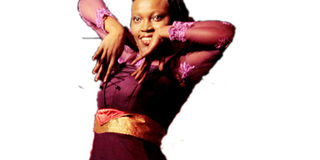When dance seeks answers to feminism

Portraying the experiences and troubles that women go through is the centre of the dance performances unfolding wisdom that liberates them .COURTESY PHOTO
What you need to know:
Dance. Set to break through boundaries and create works that inspire, Beautiful Feet Dance company is out to explore aspects of womanhood such as virtue, resilience, compassion and misery in their dance performances.
When was the last time somebody raised questions on the feminism movement and the entire women emancipation agenda in this country? Has the gospel gone too extreme, almost on the border of losing track? Are there things the feminists are not taking note of and should do better in articulating their message? Well, a group of vibrant, almost elite Kampala women actually think the feminism movement has lost track.
They think it is time to start posing the hard questions, if only to salvage the original woman, who they argue gets lost in the emancipation labyrinth.
This is the aptly named Beautiful Feet Dancing company Uganda, which in the words of its managing director Jacqueline Tumusime, is “an all-female dance company that draws from the roots of traditional African dances, blends them with elements of contemporary genres to create a fresh fusion of ethnic and contemporary dance”
Not your average group
And the group, founded in 2009 by Nancy, Kacungira and professional dancer Catherine Nakazibwe strives to establish its niche on advancing the feminism cause through dance. Contemporary dance at that, whose origins date as far back as the 1920s is as a protest to ballet.
Certainly, the group, managed by Autumn Ventures with training studios in Makindye, a Kampala suburb, is not a charity. Like any social enterprise, they are out to hunt for some money. The name, Beautiful Feet, is derived from the book of Isaiah Chapter 52, that acclaims the beautiful feet of those who bring good news. The group is not your average dance group that will stage performances for the sake of bagging the money after pulling crowds.
The girls, many of them corporates drawn from different career pools in their mid 20s, pride in their diverse and all culture embracing style, performing a variety of dances, each enveloped with a message that touches on aspects of womanhood such as virtue, resilience, compassion and misery.
For instance, to portray the message of resilience in a single mother, 24 year old Florence Ndagire twists her body to a rigorous West African dance that engages all parts of the body, she swings her hands in the air, throws the legs crossways and gets lifted by a colleague as tranquil music from Qwela Band plays in the background.
Another set of dancers take on Dance from the heart, fusing western Uganda dance, ekitagururo, Indian dance and Buganda’s Bakisimba, to play out pertinent issues afflicting the ordinary woman like domestic violence while in essence questioning the woman too. Their attire, designed by Ras Kasozi, a renowned fashion designer in his own right, is also inclined to the theme. This was evident at their latest 30 minute production at Sheraton Kampala Hotel on 5 July which questioned feminism, “Is there a danger of women losing themselves in the pursuit of their emancipation?”
For Ndagire, a sponsorships coordinator with Watoto Church ministries, “it is easier to act out something that comes from the heart, we identify with our performances because many of us have gone through these experiences. We are not just articulating the woman’s troubles, we identify with them so the dances are not choreographed, they come from the heart.”
Reviving the original woman
Ndagire, who speaks with Bible in hand during our interview and quotes it often, is convinced her performances can, “touch a soul and revive the original woman, that woman God created in Genesis who is beautiful, hardworking and responsible. Through our dance we are saying you can be a CEO but you don’t have to overthrow your husband.”
These issues, Tumusime emphasises, form the backbone of their performances, and company philosophy, “we think contemporary dance has been abstract, we endeavour to remove it from the theatre and tailor it to issues the society relates with. We keep talking of the girl child education but where is the boy child? Feminists always bash the male species, but are we not being blind to our own weaknesses? You hear female activists advocating for homosexuality. Now what is that? These are the issues we want to bring out through contemporary dance.”
But well, how do you advance that conversation beyond the dance floor and audience seats? At Sheraton for instance, over 1,000 guests attended but how sustainable or even measurable is the impact of the dance?
“Sustainability is not our worry because these issues affect the everyday person, ours is to set the agenda, we want to first start that dialogue through dance,” Tumusime explains. At the Sheraton, there was a 40 minute dialogue after the dance by eminent women activists like Dr Miria Matembe who discussed the feminism question. And yes, if policy dialogue and dance are fused, then the question on feminism might be in the right hands.




